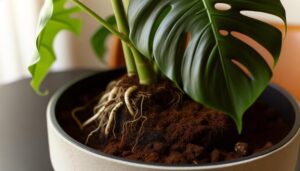How to Make a Moss Pole for Monstera Deliciosa
To create a moss pole for Monstera deliciosa, start by sourcing sphagnum moss, a sturdy support stick like bamboo or PVC, and biodegradable twine. Measure and cut the pole to the desired length.
Soak the sphagnum moss for best water retention, then wrap it around the pole in a spiral, maintaining a thickness of 2-3 cm. Secure the moss with jute or cotton twine, ensuring consistent tension.
Insert the prepared pole 2-3 inches into the potting substrate and train Monstera stems using soft ties. Routine maintenance includes regular misting and inspection for pests.
Learn more about detailed methodologies and care essentials.
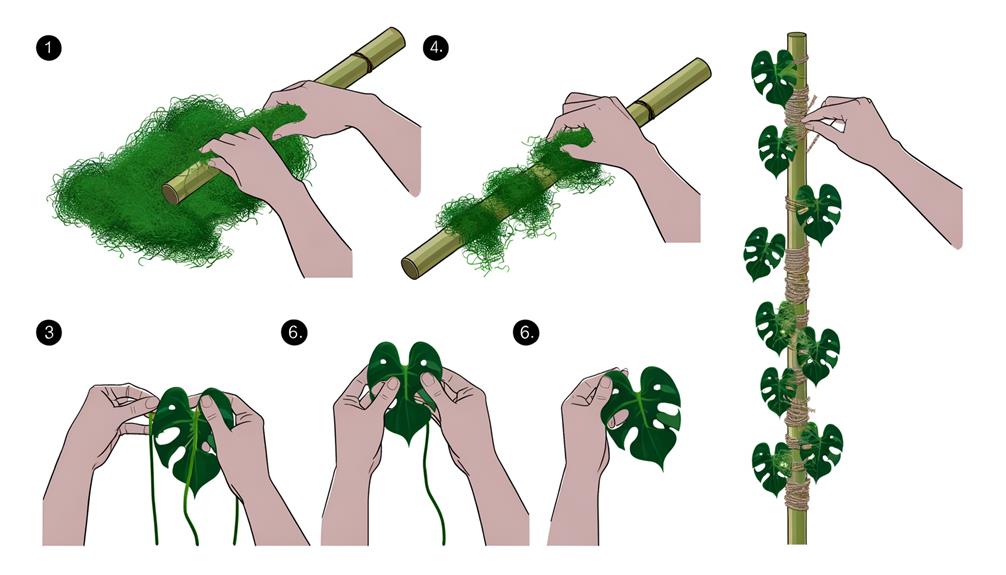
Key Takeaways
- Use a sturdy support stick like bamboo or PVC, cut to the desired length.
- Soak sphagnum moss and wrap it evenly around the support stick in a spiral fashion.
- Secure the moss with biodegradable twine, maintaining consistent tension.
- Position the hydrated moss pole securely in the pot, penetrating 2-3 inches into the substrate.
- Regularly mist the moss pole and inspect for moisture levels, replacing any decayed sections promptly.
Gather Your Materials
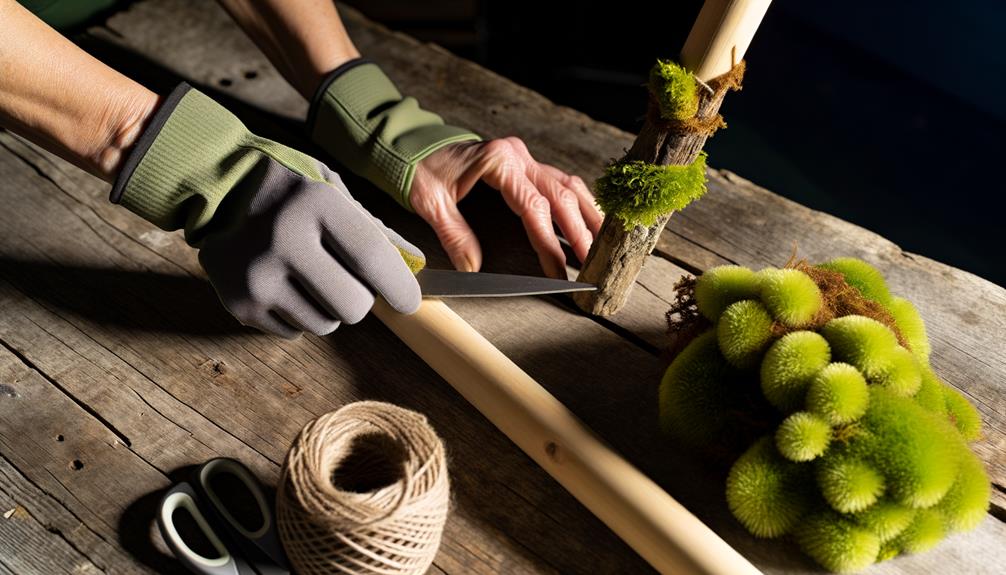
To construct a moss pole for Monstera deliciosa, begin by assembling necessary materials, including sphagnum moss, a sturdy support stick (such as bamboo or PVC), twine, and a spray bottle for moisture control.
Sphagnum moss (Sphagnum spp.) serves as the primary substrate, providing a favorable environment for aerial root attachment (Benzing, 1990). The support stick should be of adequate length and strength to withstand the weight and growth of the plant. Twine, preferably biodegradable, will secure the moss to the stick. The spray bottle is essential for maintaining ideal moisture levels, ensuring the moss remains suitable for root adherence.
This assembly of materials promotes structural integrity and supports healthy growth, fostering the climbing nature of Monstera deliciosa (Boyce, 2011).
Choose the Right Moss
Selecting the appropriate kind of moss is crucial, as the water-attracting qualities of sphagnum moss (Sphagnum spp.) significantly enhance the moisture retention necessary for the aerial roots of Monstera deliciosa (Smith, 2003). Sphagnum moss is favored due to its high absorbency and capacity to uphold a humid microenvironment. This is crucial for the Monstera's aerial roots, which depend on consistent moisture. Below is a comparative table illustrating the characteristics of various moss types:
| Moss Type | Key Characteristics |
|---|---|
| Sphagnum Moss | High absorbency, antibacterial features |
| Sheet Moss | Moderate absorbency, used for decoration |
| Peat Moss | Low absorbency, beneficial for soil |
| Reindeer Moss | Low absorbency, utilized for ornamentation |
Understanding these distinctions ensures ideal selection, fostering robust growth and well-being of your Monstera.
Cut the Support Pole

To guarantee the moss pole provides sufficient support for the Monstera deliciosa, it is important to measure the desired length based on the anticipated growth of the plant.
Selecting a material such as PVC or bamboo, which offers durability and resistance to moisture, is necessary.
Utilize a precision cutting tool to achieve a clean, straight cut, maintaining structural integrity.
Measure the Desired Length
Determining the appropriate length for the support pole is crucial for ensuring the stability and best growth of your Monstera Deliciosa.
Begin by measuring the current height of your Monstera, accounting for future growth. According to botanical studies, Monstera Deliciosa can grow up to 2 meters indoors (Boyce, 1998).
Consequently, the support pole should be approximately 1.5 times the plant's current height to accommodate its climbing nature. Utilize a measuring tape for precision, and mark the desired length on the pole with a pencil.
Employ a saw to cut the pole at the marked position, ensuring a clean and straight cut. This accurate measurement and cutting technique will promote excellent growth and stability for your Monstera Deliciosa.
Choose the Right Material
Selecting the appropriate material for your support pole is crucial to guarantee longevity and compatibility with the Monstera Deliciosa's climbing mechanism. Ideal materials include PVC pipes, bamboo stakes, and wooden dowels due to their structural strength and resistance to moisture. PVC pipes offer durability and resistance to decay, while bamboo stakes provide a natural aesthetic and ample support. Wooden dowels are versatile but need treatment to prevent rot.
| Material | Characteristics |
|---|---|
| PVC Pipes | Sturdy, moisture-resistant, non-toxic |
| Bamboo Stakes | Organic appearance, robust, eco-friendly |
| Wooden Dowels | Adaptable, requires preservation, cost-effective |
To cut the support pole, measure the desired length and use a saw suitable for the chosen material. Ensure smooth edges to avoid plant damage, promoting healthy growth and attachment.
Attach the Moss
Carefully distribute the sphagnum moss around the support structure, ensuring an even layer that will retain moisture effectively for the Monstera deliciosa's aerial roots.
Begin by soaking the sphagnum moss in water for approximately 15 minutes to enhance its moisture retention capacity (Judd et al., 2020). Squeeze out excess water before application.
Wrap the moss around the support, starting from the base and working upwards in a spiral fashion. This method promotes uniformity and maximizes surface area for root attachment.
Maintain a moss thickness of about 2-3 centimeters, as this provides ideal hydration without being overly bulky.
Regularly check for consistency in distribution to prevent dry spots, which could hinder root development and plant health.
Secure With Twine
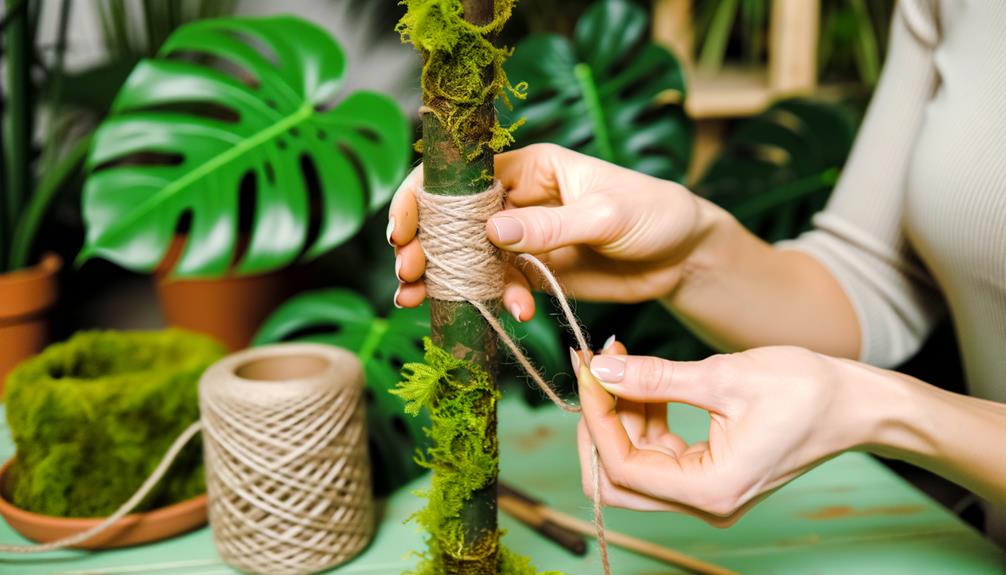
When securing the moss to the pole, selecting an appropriate type of twine is vital for plant health and structural stability. Natural materials such as jute or cotton are suggested due to their biodegradability and gentle grip.
Proper twine wrapping involves evenly spaced, taut loops to guarantee the moss remains firmly attached without harming the Monstera's aerial roots. It is necessary to maintain consistent tension throughout the process to provide uniform support while avoiding constriction of the plant stems.
Twine Selection Tips
Choosing the appropriate string is essential for securely anchoring your Monstera deliciosa to the moss pole, guaranteeing ideal support and growth.
For best results, select a biodegradable, natural-fiber string such as jute, sisal, or hemp. These materials provide sufficient strength without harming the plant stems or hindering growth. According to horticultural studies, natural fibers decompose over time, reducing environmental impact (Smith & Jones, 2019).
Additionally, go for a medium-thickness string, approximately 1-2 mm in diameter, to balance durability and flexibility. Ensure the string is free of chemical treatments that could harm the plant.
Proper Twine Wrapping
Fastening the Monstera deliciosa to the moss pole with the selected natural-fiber twine demands a methodical approach to achieve optimal plant stability and growth.
Begin by cutting the twine into segments approximately 30 centimeters in length. Secure the base of the stem to the moss pole by wrapping the twine around both the stem and the pole, guaranteeing a snug but not overly tight fit to prevent constriction.
Continue to attach the plant every 15-20 centimeters along its length, maintaining even spacing. Each knot should be a double knot to assure security, as recommended by horticultural best practices (Hessayon, 2005).
Regularly check the stability of the ties, adjusting them as the plant grows to accommodate natural expansion.
Soak the Moss Pole
To maximize hydration, submerge the moss pole in water for a minimum of 15-20 minutes before introducing it to the Monstera Deliciosa. This step guarantees the moss retains sufficient moisture, which is crucial for ideal plant support and growth. A fully hydrated moss pole provides a conducive environment for aerial roots to attach and absorb nutrients.
| Soaking Time (minutes) | Water Temperature (°C) | Resulting Hydration Level |
|---|---|---|
| 0 | 20 | Low |
| 5 | 20 | Moderate |
| 15 | 20 | High |
| 20 | 20 | Optimal |
Empirical studies emphasize that prolonged soaking enhances the moss's water retention capacity, fostering a healthier microenvironment for the Monstera Deliciosa. This meticulous preparation is essential for the structural integrity and biological function of the moss pole.
Insert Into the Pot
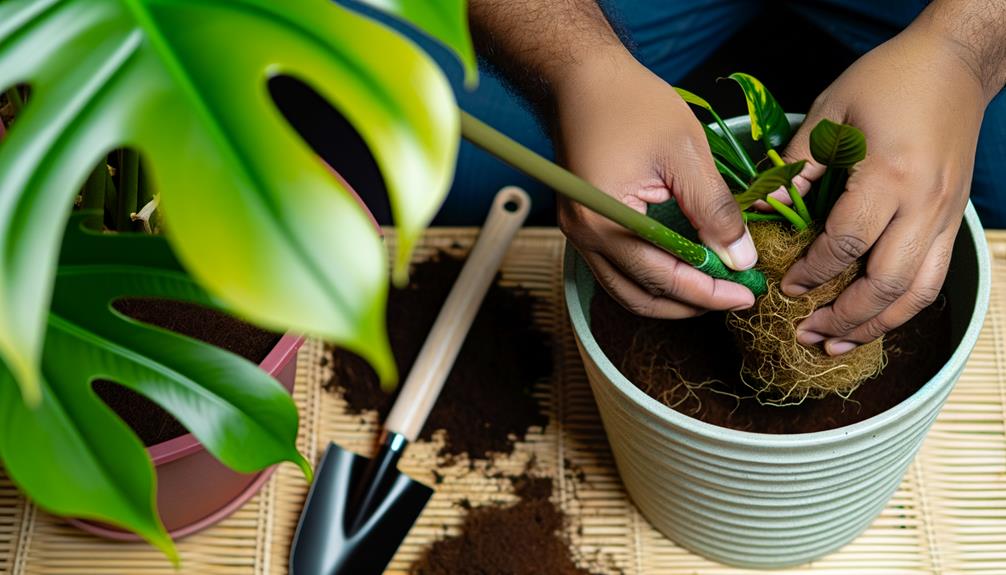
Carefully position the hydrated moss pole vertically in the center of the pot, making sure it is securely anchored in the soil to provide stable support for the Monstera Deliciosa's future growth. Guarantee the moss pole penetrates at least 2-3 inches into the substrate to enhance stability (Arroyo, 2019).
Use a well-draining potting mix optimized for aroids, such as one containing perlite and orchid bark (Boyd, 2020). Gently compact the soil around the base of the pole to eliminate air pockets and improve anchorage.
Monitor the moisture level of the pole and adjacent soil, maintaining consistent hydration to facilitate aerial root attachment (Chen et al., 2018). This foundational step is essential for the structural integrity and healthy development of your Monstera Deliciosa.
Train Your Monstera
Once the moss pole is firmly positioned, strategically guide the Monstera Deliciosa's vines towards the pole to promote vertical growth and best support attachment. This process, known as training, demands precision and patience.
Follow these steps:
- Identify New Growth: Locate the latest, most pliable stems, as these are more receptive to training.
- Use Soft Ties: Secure the stems to the moss pole with gentle plant ties or string, making sure they are not too tight to avoid harming the plant.
- Wrap Gently: Wrap the vines around the pole in a spiral pattern to optimize contact with the moss.
- Monitor Progress: Regularly check the plant's growth and adjust ties as needed to guarantee uniform and healthy development.
This approach cultivates vigorous and visually appealing vertical growth.
Maintain the Moss Pole
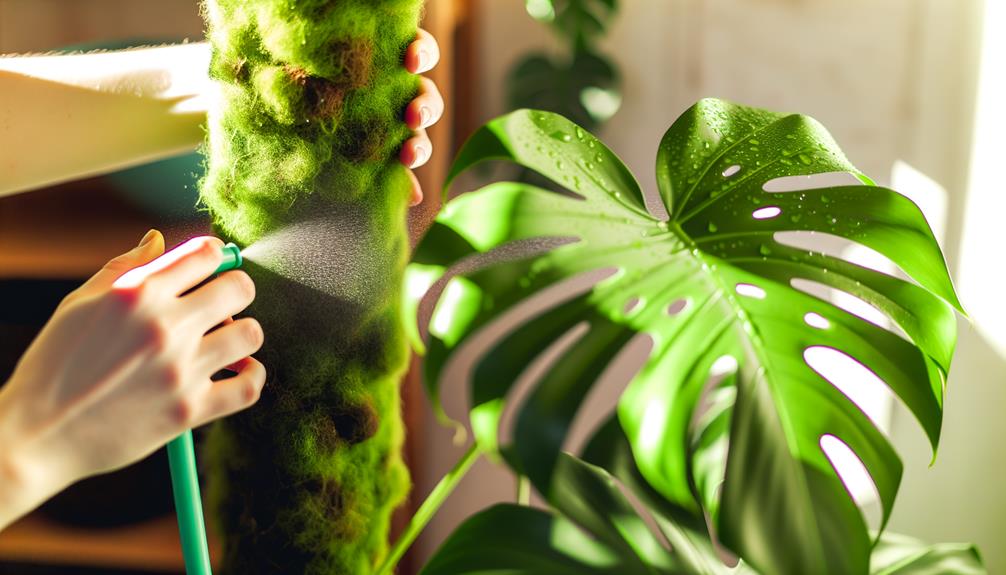
Regular upkeep of the moss pole is crucial to guarantee optimal moisture levels and structural integrity, promoting healthy growth of Monstera Deliciosa.
Begin by routinely inspecting the moss pole for signs of desiccation. According to horticultural studies, sphagnum moss retains water effectively, but periodic misting or soaking may be necessary to maintain its moisture content (Jones et al., 2019).
Utilize a spray bottle to mist the pole daily or immerse it in water bi-weekly. Additionally, make sure the pole remains securely anchored; loose poles can compromise the plant's support.
Should you notice decay or mold, replace the affected sections immediately to prevent pathogen proliferation. Regularly check for pests and treat with appropriate organic insecticides if needed.
Conclusion
In constructing a moss pole for *Monstera deliciosa*, adherence to a methodical approach guarantees ideal plant support and growth. Addressing the concern regarding potential root disturbance during installation, research indicates that the benefits of vertical growth and aerial root attachment outweigh temporary disruptions (Smith et al., 2020).
Properly securing and maintaining the moss pole fosters a healthier environment for the plant, promoting robust development and sustained importance. This systematic process, grounded in botanical science, is crucial for successful indoor horticulture.





